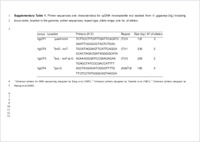Range-wide patterns of nuclear and chloroplast DNA diversity in Vriesea gigantea (Bromeliaceae), a neotropical forest species
- Palma-Silva, Clarisse Departamento de Genética, IB/UFRGS, Rio Grande do Sul, Porto Alegre, Brazil - Jodrell Laboratory, Royal Botanic Gardens Kew, Richmond, Surrey, UK - Department of Biology, Unit of Ecology and evolution, University of Fribourg, Switzerland
- Lexer, Christian Jodrell Laboratory, Royal Botanic Gardens Kew, Richmond, Surrey, UK - Department of Biology, Unit of Ecology and evolution, University of Fribourg, Switzerland
- Paggi, G. M. Departamento de Genética, IB/UFRGS, Rio Grande do Sul, Porto Alegre, Brazil
- Barbará, Thelma Jodrell Laboratory, Royal Botanic Gardens Kew, Richmond, Surrey, UK - Department of Biology, Unit of Ecology and evolution, University of Fribourg, Switzerland
- Bered, F. Departamento de Genética, IB/UFRGS, Rio Grande do Sul, Porto Alegre, Brazil
- Bodanese-Zanettini, M. H. Departamento de Genética, IB/UFRGS, Rio Grande do Sul, Porto Alegre, Brazil
-
09.09.2009
Published in:
- Heredity. - 2009, vol. 103, p. 503–512
bromeliad
Brazilian Atlantic Rainforest
marginal populations
microsatellite
population genetics
biodiversity
English
The processes that have shaped the extraordinary species diversity in neotropical rainforests are poorly understood, and knowledge about the patterns of genetic diversity across species' ranges is scarce, in contrast to other regions of the globe. We have conducted a range-wide study of genetic diversity in a plant endemic to the Brazilian Atlantic Rainforest, Vriesea gigantea (Bromeliaceae), based on a combined data set of nuclear microsatellites and chloroplast (cp) DNA markers typed in 429 plants from 13 populations. The results indicate a strong negative correlation between genetic diversity and population latitude, consistent with historical forest expansion from the northern half of the present distribution range. A deep phylogeographic split exists between the Brazilian states of São Paulo and Rio de Janeiro at ca. 23 °S latitude, probably reflecting past population isolation within more than one glacial refuge during the climatic changes of the Pleistocene. A comparison of genetic structures at cpDNA and nuclear markers revealed a pollen/seed flow ratio of more than 3:1, thus indicating an important role of the pollinating animals (that is, bats) in shaping the population genetic structure of this species. Diversity was reduced for cpDNA markers in the island populations off the coast, and reduced diversity and increased differentiation were observed for both nuclear and cpDNA at the edges of the species' range. The link between patterns of genetic and species diversity supports the hypothesis that both were shaped by the same biogeographic processes, triggered by the climatic oscillations of the Pleistocene.
- Faculty
- Faculté des sciences et de médecine
- Department
- Département de Biologie
- Language
-
- English
- Classification
- Biological sciences
- License
-
License undefined
- Identifiers
-
- RERO DOC 17234
- DOI 10.1038/hdy.2009.116
- Persistent URL
- https://folia.unifr.ch/unifr/documents/301514
Other files
Statistics
Document views: 125
File downloads:
- pdf: 223
- Supplementary material: 118

